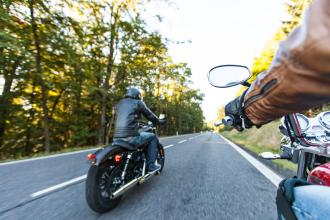Cannabis and motor vehicle crashes
Every year in Canada, 125 000 car crashes result in over 12 000 serious injuries and 2400 fatalities.
Drinking drivers are at increased risk of crashing. The crash risk doubles at blood alcohol levels (BALs) between 0.05% and 0.08% and increases over 150-fold at BALs above 0.24%.
After alcohol, cannabis is the second most widely used impairing drug in the world, and many Canadians drive after using cannabis. The rate of cannabis use in BC drivers is particularly high. A 2008 BC survey in the Lower Mainland and on Vancouver Island found that 8.1% of drivers had been drinking and 10.4% tested positive for drugs, including 4.6% for cannabis.[1]
The rate of cannabis use is even higher in other parts of BC. However, many cannabis users believe it does not impair their driving ability. The true contribution of cannabis to motor vehicle crashes (MVCs) is therefore of substantial interest.
There is clear evidence that cannabis, like alcohol, impairs the psychomotor skills required for safe driving.[2] Cannabis intoxication slows reaction time and impairs automated tasks such as tracking ability (staying within a lane) or monitoring the speedometer.
In simulator studies, high doses of cannabis caused drivers to “crash” into a sudden obstacle more often. However, the impairment caused by so-called equivalent doses of cannabis and alcohol differ in important ways. Moderate doses of cannabis impair highly automated tasks but leave complex functions such as interpretation and anticipation of traffic patterns relatively intact whereas alcohol has the opposite effect.
In experimental driving conditions, cannabis users tend to reduce their driving speed and are less likely to attempt to overtake and pass another vehicle, whereas drunk drivers tend to drive faster and more aggressively.[3] Furthermore, cannabis users tend to overestimate their impairment whereas people who used alcohol underestimate theirs.[2-4]
Therefore, some researchers have suggested that cannabis users might be able to avoid crashes by compensating for their impairment. However, several lines of evidence suggest that this is not the case.
Canadian surveys suggest that drivers who use cannabis are at increased risk of crashing. Asbridge and colleagues surveyed Canadian students and found that those who drove after using cannabis were almost twice as likely to have crashed their car.[5] Mann and colleagues analyzed surveys of Ontario adults and also found that cannabis-using drivers were more likely to crash.[6]
The best evidence around cannabis and MVCs comes from modern “culpability studies” from Australia[7] and France,[8] which found that crashed drivers who used cannabis were more likely to have caused the crash than drug- and alcohol-free drivers. However, this risk was relatively small—comparable to that associated with alcohol levels between 0 and 0.05%.
These studies had limitations: none accounted for North American driving conditions or drug use habits (which may limit their applicability to Canadian traffic policy), and there was a significant delay from crash until blood was obtained, so measured cannabis levels were much lower than actual levels at time of crash.
Many British Columbia drivers use cannabis. Cannabis impairs the psychomotor skills required for safe driving, and the available epidemiological evidence suggests that cannabis does increase the risk of crashing. However, this risk, and how it varies with cannabis dose, is not well quantified. This uncertainty hinders the development of effective road safety policy targeting cannabis-impaired driving.
North American studies with large numbers of cannabis-using drivers are required to better understand the contribution of cannabis to car crashes. We have just launched a British Columbia study that will recruit 3000 crash-involved drivers from five BC emergency departments. This important study will provide insight into the contribution of cannabis to car crashes here in BC.
—Jeffrey R. Brubacher, MD, FRCPC(EM)
Member, Emergency Medical Services Committee
This article is the opinion of the Council on Health Promotion and has not been peer reviewed by the BCMJ Editorial Board.
References
1. Beirness DJ, Beasley EE. A roadside survey of alcohol and drug use among drivers in British Columbia. Traffic inj prev 2010;11:215-221.
2. Ramaekers JG, Berghaus G, van Laar M, et al. Dose related risk of motor vehicle crashes after cannabis use. Drug Alcohol Depend 2004;73:109-119.
3. Grotenhermen F, Leson G, Berghaus G, et al. Developing science-based per se limits for driving under the influence of cannabis (DUIC): Findings and recommendations by an expert panel. Report International Association for Cannabis as Medicine. 2005.
4. Sewell RA, Poling J, Sofuoglu M, et al. The effect of cannabis compared with alcohol on driving. Am J Addict 2009;18:185-193.
5. Asbridge M, Poulin C, Donato A, et al. Motor vehicle collision risk and driving under the influence of cannabis: Evidence from adolescents in Atlantic Canada. Accid Anal Preven 2005;37:1025-1034.
6. Mann RE, Adlaf E, Zhao J, et al. Cannabis use and self-reported collisions in a representative sample of adult drivers. J Safety Res 2007;38:669-674.
7. Drummer OH, Gerostamoulos J, Batziris H, et al. The involvement of drugs in drivers of motor vehicles killed in Australian road traffic crashes. Accid Anal Preven 2004;36:239-248.
8. Laumon B, Gadegbeku B, Martin JL, et al. Cannabis intoxication and fatal road crashes in France: Population based case-control study. [erratum appears in BMJ 2006;332(7553):1298]. BMJ 2005;331:1371.

